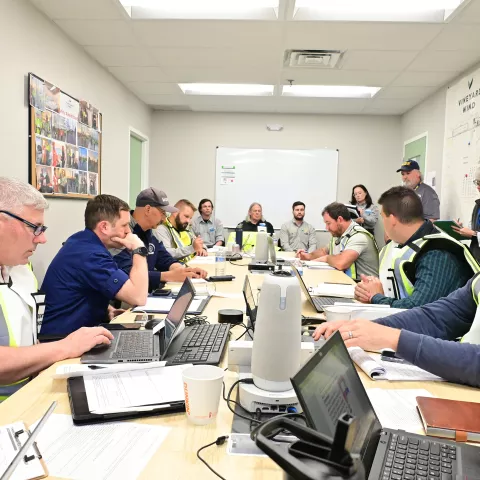
WASHINGTON – As the lead federal agency for the development of workplace safety and environmental compliance strategies for offshore conventional and renewable energy projects on the federal Outer Continental Shelf, the Bureau of Safety and Environmental Enforcement (BSEE) today conducted the first-ever Government Initiated Unannounced Exercise (GIUE) of an offshore renewable energy facility. The GIUE at Vineyard Wind’s Marine Coordination Center in New Bedford, Massachusetts, successfully evaluated Vineyard Wind’s ability to activate an incident management team and carry out the procedures in their approved oil spill response plans.
“While there is no risk of a major blowout, offshore wind farms use significant amounts of oil and other fluids, so the ability to respond quickly to a spill is just as important as it is for oil and gas operations,” said BSEE Director Kevin Sligh. “BSEE conducts formal evaluations as part of its mission to protect the environment and ensure offshore wind energy operators are prepared to respond rapidly and effectively to spills.”
The exercise simulated a diesel spill from a 700-gallon capacity fuel tank on a Vineyard Wind electrical service platform located about 18 miles offshore. In the scenario, a fisherman pulling nets contacted the National Response Center after observing a sheen in the water. While there is no minimum volume that triggers the deployment of response equipment, federal regulations mandate reporting even a single drop of spilled oil.
“These exercises are an excellent opportunity for BSEE to collaborate with federal, state, and Tribal partners who have mutual interests in offshore spill preparedness and response,” said BSEE Oil Spill Preparedness Division Chief Eric Miller.
BSEE, the U.S. Coast Guard, National Oceanic and Atmospheric Administration and the Massachusetts Department of Environmental Protection, participated in assessing Vineyard Wind’s ability to make timely notifications to the National Response Center and BSEE. They also evaluated Vineyard Wind’s ability to mobilize and organize staff to operate within a Unified Command, plan for the protection of the environment, develop recovery strategies, and establish effective communications. The Mashpee Wampanoag Tribe, the Wampanoag Tribe of Gay Head, and the Shinnecock Indian Nation were also notified of the exercise by Vineyard Wind in accordance with their response plan.
“These exercises test an operator’s spill response plan and their ability to respond to a hypothetical spill scenario,” said Sligh. “GIUEs provide an important opportunity to ensure each of the entities involved can adequately respond in the event of an emergency, and that corrective actions are taken based on lessons learned.”
The Vineyard Wind facility, which started delivering power in January 2024, is one of the nation’s first commercial utility-scale offshore wind projects, and is capable of generating energy for more than 400,000 homes and businesses across Massachusetts, while reducing carbon emissions by over 1.6 million tons per year.
-BSEE-
The Bureau of Safety and Environmental Enforcement is the lead federal agency charged with improving safety and ensuring environmental protection related to the offshore energy industry on the U.S. Outer Continental Shelf.
